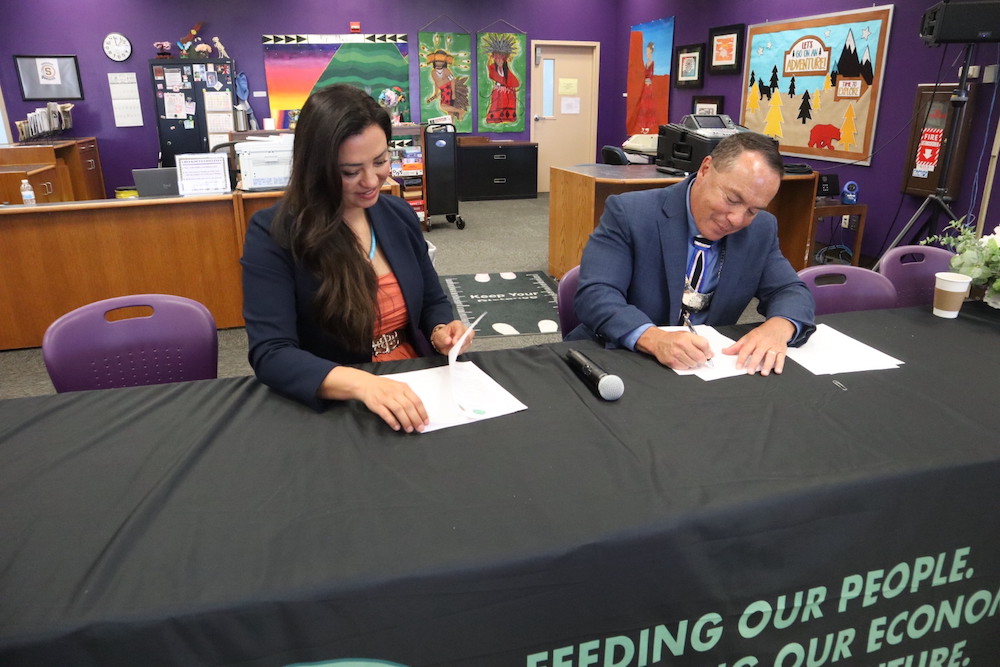
- Details
- By Chez Oxendine
- Food | Agriculture
The Bureau of Indian Education has partnered with the Native American Agriculture Fund to expand agricultural education resources for tribal schools.
The two organizations have signed an agreement to develop and distribute supplementary educational materials for Native students. The Tribal Agriculture Fellowship Program, a NAAF sister organization, will tailor those materials for particular regions and tribes. Topics will run the gamut — from traditional agricultural practices to leadership to plant science.
In addition, NAAF will distribute $50,000 this year and next to the Indigenous Food Hubs program under the BIE. That program provides four pilot sites with project-based training and interactive materials. NAAF funding will support two of those pilot sites, beginning with Wingate High School in Gallup, New Mexico.
All of this will help train the next generation of Native American agricultural producers, NAAF CEO Toni Stanger-McLaughlin said.
“This collaborative lifelong agriculture education effort addresses a crucial gap in agricultural education,” Stanger-McLaughlin said. “It aims to empower Native students with education to preserve generational knowledge and sustain holistic agricultural ecosystems.”
The partnership comes on the heels of new degree programs springing up at tribal colleges like Haskell University. Haskell announced an agricultural degree program in partnership with NAAF in February this year.
Stanger-McLaughlin spoke with Tribal Business News to discuss the resources that will be created through this new partnership.
What is NAAF bringing to the table with this partnership with BIE?
There's multiple parts to our work together, but the foundation of it was built off the MOU (memorandum of understanding) we signed with the National Future Farmers of America organization last year. We’ve developed model supplementary-educational materials for schools to build off of so they can develop their own culturally relevant education.
How does this relate to that MOU?
Future Farmers of America has a lot of opportunities for developing your skills as a public speaker, showing animals, and learning how to debate. We want to make sure tribes have access to those programs too. Part of this partnership is getting FFA educators into these schools.
What was the barrier to bringing those in before?
For FFA educators to operate within a school, every state has different guidelines. The jurisdictional hoops you have to jump through to keep an agriculture educator in your county is tough as it is. One of the things that drew us to this partnership was realizing it’s even harder for tribes.
I’m a member of the Confederated Colville Tribes. We have 1.4 million acres on our reservation - and for a long time we only had one agriculture educator that had to work across multiple counties. We hope that we can work together with BIE and bridge that gap a little bit.
What do you mean when you talk about tailoring modules for particular tribes?
The Tribal Agricultural Fellowship Program helps create these materials because two of the people involved - Jasmine Locklear and April Parrott - are former educators. They’re going to work with schools in refining these materials. For example, some of one of the modules was on rice, and there was another on bison, or on salmon. They’re all different, and those foods are specific to particular regions.
We want kids in the Southwest to learn about maize, whereas kids in the Great Lakes Region are going to learn about wild rice.
What prompted the financial support to the Indigenous Food Hubs program?
Those hubs provide hands-on learning for students. For example, they have culinary arts classes, with students learning to become chefs - that helps build a relationship with local producers, and can help local producers learn how to sell into the school setting or other new markets in their region.
It’s not often you see external funding for federal projects like this.
I think it's a wonderful opportunity - it's something that not a lot of other entities were in a place to do. The fact that NAAF doesn't seek out any other additional federal funding for itself allowed us to enter into this relationship as a funder. That’s important, because there’s not a lot of Native-focused funding organizations like this in the United States. It’s just another way we can even the playing field for our Native students.
What makes partnerships like these important?
It’s really hopefully encouraging students into agricultural careers, whether that’s directly on a farm or ranch or in communications or marketing - anything that can support agriculture, we want students to know that’s an opportunity.
